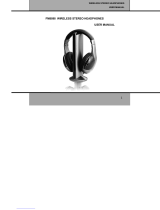
Important safety information
RS 185 | 3
Important safety information
왘 Read this instruction manual carefully and completely before using the
product.
왘 Always include this safety guide when passing the product on to third
parties.
왘 Do not use an obviously defective product.
Preventing damage to health and accidents
왘 Protect your hearing from high volume levels. Permanent
hearing damage may occur when headphones are used at
high volume levels for long periods of time. Sennheiser head-
phones sound exceptionally good at low and medium volume levels.
왘 Do not use the product in situations which require special attention
(e.g. in traffic or when performing skilled jobs).
왘 Keep the headphones at least 10 cm/3.94” from cardiac pacemakers or
implanted defibrillators. The headphones contain magnets that gener-
ate a magnetic field which could cause interference with cardiac pace-
makers and implanted defibrillators.
왘 Do not use the product near water and do not expose it to rain or mois-
ture to reduce the risk of fire or electric shock.
왘 Keep the product, accessories and packaging parts out of reach of chil-
dren and pets to prevent accidents and choking hazards.
왘 Use only power supply units provided by Sennheiser.
Preventing damage to the product and malfunctions
왘 Always keep the product dry and do not expose it to extreme tempera-
tures to avoid corrosion or deformation. The normal operating tem-
perature is from 0 to 40°C/32 to 104°F.
왘 Use the product with care and store it in a clean, dust-free environ-
ment.
왘 Do not use the product if it is obviously defective, if it has been dropped
or if liquids or objects have gotten inside the product. In this case, con-
tact a qualified specialist workshop or your Sennheiser service partner
to have the product checked.
왘 Switch the headphones off after use to conserve battery power.
Remove the batteries if the product will not be used for extended peri-
ods of time.
왘 Unplug the power supply unit from the AC wall outlet
– to completely disconnect the product from the power source,
– during lightning storms, or
– when unused for long periods of time.
왘 Ensure that the power supply unit is
– in a safe operating condition and easily accessible,
– properly plugged into the AC wall outlet,
– operated only within the permissible temperature range,
– not exposed to direct sunlight for longer periods of time in order to
prevent heat accumulation.
왘 Do not place your headphones on a glass dummy head, chair armrest or
similar objects for long periods as this can widen the headband and
reduce the contact pressure of the headphones.





















